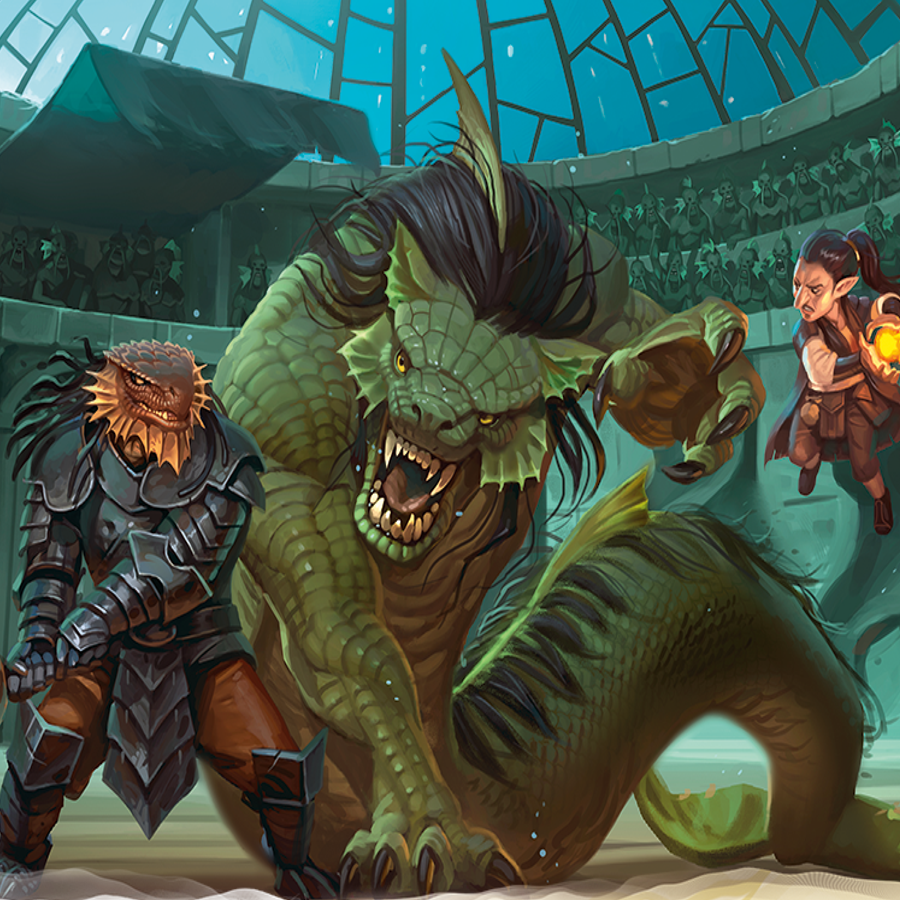The Best D&D 5e House Rules (Stolen from Pathfinder 2e)

Written by Luke Hart
Like many dungeon masters, I’ve implemented many house rules over my years of running D&D games, and I’m sure you have, too. Naturally, many of these house rules we create are intended to overcome flaws in the system and improve gameplay. Of course, some house rules turn out to be great, and others completely flop. That’s just the nature of the beast.
Since I started playing Pathfinder 2nd Edition a year ago, I’ve seen that PF2 overcomes many of the flaws inherent in D&D 5th Edition and is a better game system overall. However, I realize that not everyone wants to switch game systems, so today, I will share 10 house rules that you can steal from Pathfinder 2 to improve your D&D games.
Disclaimer: These house rules change game mechanics, and some are core mechanics that underpin large parts of the game. Whenever you mess around with these, there will likely be unintended consequences. Thus, my recommendation when implementing any house rule is to consider it carefully before implementing it and then keep an eye on things. Evaluate whether it’s working or not; maybe you can make some tweaks to improve it, but maybe it’s just not meant to be, and you need to get rid of it entirely. Also, evaluate if your group is having fun with the house rule. After all, isn’t that why we’re playing the game?
By the way, if you’d like to get over 600 pages of 5th edition game master resources for your games, you need to check out our Lairs & Legends 2. Get yourself two big, fat, beefy books stuffed full of
- Over 30 Adventures spanning levels 1 to 20
- 30 Stand-alone Encounters
- More than 100 Monsters across the entire challenge rating range
- 6 New Rule Sets
- Puzzles, Traps
- And more!
Watch the video for this article below.
1. Attack Rolls That Hit by 10 or More Are Critical Hits
I’m currently running both Pathfinder 2e and D&D 5e games. Whenever someone in my D&D game rolls really high to hit something, I find myself thinking, “If this was Pathfinder 2, that would be a crit.” So why not make it a crit?
This is something that I love about Pathfinder 2e because it does a few things to improve gameplay: First, it makes the characters feel more heroic against lower-level baddies because they are critting more, and that is an awesome feeling. Next, when the characters square off against a high-level boss with a higher to-hit bonus, that boss will crit more against them. This amps up the drama and threat of that enemy, making combat way more exciting. Third, it speeds up combat. How many times have you been in a fight in D&D 5e edition where the outcome was certain because one side was clearly way more powerful? Well, using this house rule will deplete the hit points of the losing side faster, hurrying along the inevitable conclusion.
Now, as a special consideration for 5th edition’s bounded accuracy game mechanic, which Pathfinder 2 does not use, you may consider making attack rolls that hit by 5 or more critical hits. That would make things a lot more dangerous for both sides and could be tons of fun to try just to see how it goes.
2. Alternate Methods of Initiative
Why does Dexterity always win in initiative? A perceptive character should be able to use Wisdom. A character with time to plan their attack on an ambush should be able to use Intelligence. A fighter who bullrushes the enemy should be able to use Strength. I mean, why not?
So, this is what you do. When your players roll initiative, they may, as an option, request to use a different ability score modifier to roll initiative as long as they can justify it narratively. And here’s the thing: it must key off something they were doing just before the combat broke out; it must fit the story, the narrative. Otherwise, you’ll find every player will always come up with something so that they can use their best ability score modifier. That’s why it must fit with something their character was doing before fists started flying.
Also, for those of you who play Pathfinder 2, you may be saying, “But wait, PF2 uses skill modifiers, such as Athletics, Deception, Stealth, and the like, not ability score modifiers.” And you’re right, of course. However, for this D&D 5e house rule, we don’t want to do that for two reasons: first, because of the bounded accuracy game mechanic differential, and second, because monsters in D&D 5e don’t have special initiative modifiers. They just use their dexterity modifiers and usually have crappy ones at that. So, the best a monster could hope for is a +4 or +5 bonus, and if players are routinely getting twice or three times that, it would be a lopsided house rule.
This, of course, leads us to the next point: Let monsters do the same thing! If it’s justified narratively, let them use different ability scores for initiative, too.
3. Limitations on Spell and Ability Use to Avoid Spamming
Oh, my gosh, I cannot tell you how sick I am of clerics in D&D spamming guidance for entire game sessions. Yes, I get that it’s a good cantrip in a system with bounded accuracy, and not doing it is giving up a big advantage, so it makes sense for clerics to spam it, I guess. But geesh, it gets old.
In Pathfinder 2e, certain spells and abilities have usage limits. For example, once guidance is cast on a creature, that creature is immune to the guidance spell for the next hour. I love that. It’s a common-sense limitation that stops all the spamming.
Now, be careful. I would not do this everything; instead, be very selective about the ability or spells that you apply this to. Remember, you are effectively nerfing something a player has, so they probably won’t like it much. Therefore, make sure you have a very good reason for doing so. This is not something to take lightly or toss around irresponsibly. However, when there are legitimate game balance issues or other issues being caused, this can certainly help.
4. “Natural Healing” and “Treat Wounds” Rules
Here’s a way to make short rests much more interesting and the healing less of a guarantee. You can require skill checks for healing during short rests, akin to Pathfinder 2’s Treat Wounds. For example, if a player with proficiency in Medicine makes a Medicine check of DC 10 + half the party’s level rounded down, the treated character heals two of their Hit Dice worth of healing.
Also, limiting how many times they can use the skill during a short rest, perhaps just six times, means they can use Treat Wounds once every 10 minutes.
If you want to make long rests less of a handwave of “you get all your hit points back,” you can use Pathfinder 2’s resting rules. Basically, characters heal their Constitution modifier (minimum of 1) times their level in hit points during a long rest.
Oh, and there’s a feat in PF2 called Combat Medicine we can steal, too. Make this a feat your D&D characters can pick up; if they have it, they can use a Medicine check during combat once per character to treat wounds similar to how they would during a short rest, which we just talked about.
Big Disclaimer: At this point, we’re starting to goof around with some fairly strong underlying game mechanics in D&D 5e, so there may be unexpected and perhaps undesired consequences. So, this is a house rule you want to watch carefully as you playtest your game. I mean, you playtest all house rules to see if you like them or hate them, of course, but this one could be particularly noodley.
5. Flanking
Yes, I know the Flanking alternate rule already exists in D&D 5e, but I hate it. Granting advantage is just way too powerful, and frankly, the advantage mechanic, in general, is something I don’t like about D&D 5e. Yes, it makes gameplay easier and faster than adding and subtracting modifiers to rolls, but it has some big flaws. It’s swingy at the extremes and unbalances “crit fishing” characters such as rogues and paladins. It’s a sloppy game mechanic overall, but we’ll save that rant for another time.
Instead, just grant a -2 armor class penalty to a flanked enemy. This is what PF2 does with their flat-footed or off-guard condition. That’s a much more reasonable adjustment than granting advantage on attack rolls.
6. Are you Sick? Why Not Try Throwing Up?
This one is gross, but in Pathfinder 2e, I love that characters can voluntarily use an action to make a Fortitude save to vomit and reduce the sickened condition.
You can apply this to the D&D poisoned condition. If a character uses their action to throw up or take another action to overcome their poisoning, they get to make another Constitution save to get rid of the poisoned condition.
But why stop there? You can probably do something similar for other conditions. I’m not going to go through the entire list, but for some conditions, it might be reasonable for characters to use an action—not a bonus action or free action, mind you—to attempt to remove a condition that is ailing them.
Stunning Fist, I’m looking at you. Perhaps I use my action to clear my head, and if I make my Con save, I can at least move away from that horrible monk.
7. Change Cantrip Damage Scaling
Look, I know this exists in D&D 5e, but damage powerups don’t occur that often, and if you’re a player, it can take ages before your firebolt gains damage. Thus, I think that having cantrips do less damage initially but scale more often could be fun.
Consider this: Instead of firebolt doing 1d10 damage at level 1 and then 2d10 at 5th level, wouldn’t it be more fun if it did 1d6 damage at 1st level, 2d6 at third level, 3d6 at 5th level, 4d6 at 7th level, and so on? I think so.
Now, the trick here, of course, is to implement this change in such a way that you’re not actually changing the damage the cantrip deals that much. This is a house rule for its psychological benefit and to make things more fun. Our quick and dirty method for scaling cantrips is to do this. First, cantrip damage dice are reduced by two steps. So, a d10 becomes a d6, a d8 becomes a d4, and so on, to a minimum of d4. Then, the damage increases by that amount at every other level. So, your damage increases come at levels 3, 5, 7, and so on.
8. The Step Action
Goodbye Disengage, hello Step. Look, using an entire action to Disengage is just brutal. This means, essentially, that you Disengage and move away on your turn, only to have the enemy on their turn move after you and attack anyway. Like, what did you actually gain? This is why retreating from combat is practically impossible in D&D 5e. It’s usually a death sentence, so you might as well just stand your ground and fight to the death.
Instead, let’s make Disengage a bonus action—sorry, rogues, sorry—so that retreating is an actual option in the game. If that seems too powerful, give players the option: Disengage as an action to not provoke attacks at all, or, Disengage as a bonus action to confer disadvantage on opportunity attacks. Then your players have options, and the more action economy they use, the better the results.
Of course, another option is to make it so that not everyone gets opportunity attacks, but we’re going to talk about that a bit more in a moment.
9. The Three-Action Economy
Perhaps one of my favorite parts of Pathfinder 2 is the three-action economy. Look, this is what happens on the average player’s turn in D&D 5e. They take an action of some sort, you resolve it, and then there is a long pause. As the DM, you may assume they are done, so you move to the next player. However, the first player is like, “No, wait; let me see if there is a bonus action I can use.” So you wait, and then they are like, “Nope, nothing. Never mind.” So, you go to the next player, and the first is like, “Wait, I think I might actually want to move, too.” So, they move.
This results in a back-and-forth “done not done,” or you simply prompt the player every time, “Are you done?” “Do you want to move?” “Any bonus actions?” I’m telling you, on paper, action, movement, and bonus action are fine, but in practice, it is a sloppy way to play the game. Now, you may be saying, “But Luke, that’s just your players. Get better players!” And that’s fair; some players are like that. However, I have had the advantage of playing with the same group for years in D&D 5e and then moving that same group over to Pathfinder 2e. And let me tell you from first-hand experience that it works.
Using the three-action economy of Pathfinder 2 speeds up our turns and lets me, the game master, know exactly when a player is done or not. There is no back and forth, no “Oh, wait; can I also . . .” stuff going on.
So, for your D&D 5e games, eliminate the action, movement, and the bonus action system. Just make it three actions per turn. Period. You can move three times if you want. You can attack three times if you want; move once, attack twice; move twice, attack once—you get the idea.
Now, this is a change to a core mechanic, so I’m sure there will be many unintended consequences. The first one off the bat is that allowing more attacks will increase damage output; however, it also increases the DPS of the monsters, so you could argue that it’s Even Steven. So, test it out, and if it seems off, you can institute a Multiple-attack Penalty system (MAP) whereby the subsequent attacks have a penalty. Now, in PF2, it’s a -5 penalty for the 2nd attack and a -10 for the 3rd attack on a round, but in 5th edition, with its bounded accuracy, you may want to use -3 and -6 instead. However, test it first without a MAP and see how it works for you.
Next, how does this affect spellcasting? To make this quick and dirty, I’d say that every bonus action spell now requires one action, and every action spell now requires two actions. That should mostly balance things. Remember, this applies to monsters, too!
There will probably be other things that need tweaking, but just play it by ear, see how it goes, and make changes as needed.
10. Levels of Frightened, Stunned, etc.
One of the things I love about Pathfinder 2e is how you assign values to many of the conditions. For instance, you are stunned 1, stunned 2, or stunned 3, and each level of stunned takes away one of your actions. So, if you are just stunned 1, you still have two actions on your turn, and then at the end of your turn, your stunned value decreases by 1. This makes it so that unless a character or monster critically fails their stun saving throw, they are not just removed from combat entirely.
Now, implementing this would take quite a bit of rework to 5e’s core rules, frankly, and I don’t have any quick rules of thumb for you, but man, wouldn’t it be nice?
Honorable Mention: More Cool Reactions, Fewer Attacks of Opportunity
Now, I love the poison and disease rules in Pathfinder 2—they actually make sense! They have a set duration, and you can save to overcome them, but if you fail, they get more severe—or at least make it so that you must save more than once to recover if you’ve failed multiple times.
However, my honorable mention goes to reducing the number of attacks of opportunity and instead giving characters and monsters different cool things they can do with their reactions.
In Pathfinder 2, I love that only 15-20 percent of characters and monsters have Attacks of Opportunity, and there are so many cool reactions that both monsters and characters get instead that make combat more interesting and dynamic. Some creatures have an ambush reaction when a creature moves within 20 feet of their place of hiding; others can disperse burning cinders into the air when they are struck; and yet others can use a bit of movement as a reaction.
As much as I wish the next edition of D&D coming out would use some of these Pathfinder 2 conventions—because, you know, half of the D&D design team used to work at Paizo—I’m pretty sure that’s not going to happen.
The Definitive 5e Resource Anthology
Running awesome 5e games with in-depth lore, deadly traps, and terrifying monsters doesn’t have to take hours of prep! Lairs & Legends 2 and Loot & Lore 2 have everything you need to cut your prep time in half while preserving your campaign and your story!
- Over 30 Adventures
- 30 Stand-Alone Encounters
- More than 100 Monsters
- 6 New Rule Sets
- And much more!
These books are written to make running the game easy for new and veteran GMs. Each resource is built with intuitive formatting, clear wording, and evocative art. You’ll never again have to dig through dense paragraphs to find critical details you need during a live session.
These 5e resources are designed to scale to your needs; whether it’s a quick drag-and-drop trap to add some spice to your session or complete adventures that span levels 1 to 20. The sky’s the limit with what your games can become with Lairs & Legends 2 and Loot & Lore 2.
-
Posted in
Game Master How-To Articles






